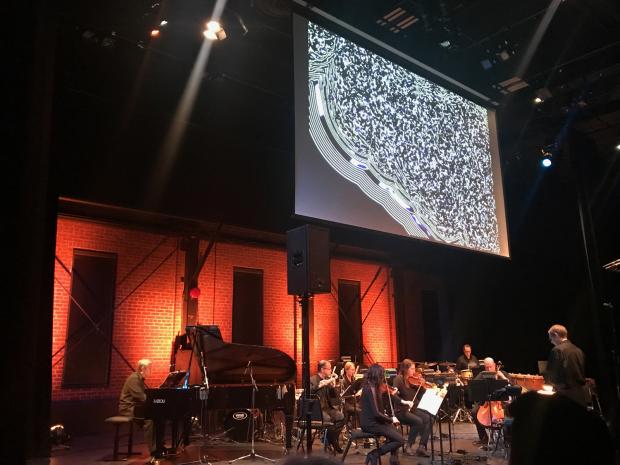
When I was asked to attend the World New Music Days ISCM 2017, some 48 hours before it began, and to write a comprehensive festival report, I was standing by for a journey to Najaf, in Southern Iraq. At night I skyped contacts in Baghdad and listened to mournful Shiah chants, their fragile beauty now exploited by sectarian agendas, and more hopeful Iraqi maqam, the secular sung love poetry that draws melodically on the music of all communities living in Iraq. As I contemplated diving into a festival welcoming 135 composers from 50 countries with 140 new music works performed by more than 300 musicians, I wondered what role music might play in uniting an increasingly fraught and divided world.
As a follow up to my 2006 book Dancing in the No Fly Zone, that documented pre and post invasion culture in Iraq and followed the fate of the Iraqi National Orchestra, I was at work on a second book Between Two Rivers, that uses ancient sites and Iraqi heritage as a narrative device to tell the story of Iraq today. The displaced persons camp in the ancient city of Babylon; the Burger King installed by the US military in Ur, birthplace of Abraham and the site of the Sumerian ziggurat; stories of young artists and musicians in the cradle of civilization where written language and medicine and law and architecture were born; connections with young composers in the land of the Chaldeans, apparently the first people to conceive of the heavenly bodies joining in a cosmic chant as they moved across the sky.
The book was first inspired during my last visit to Baghdad in 2010, on assignment for New Internationalist, when I was taken on a tour by an architect to an important Seljuk shrine in an historical area turned frontline for sectarian conflict, next to a garbage dump and a displaced persons camp. It reminded me poignantly of that last scene on the beach in Planet of the Apes, when Charlton Heston sees the Statute of Liberty submerged in the sand. (In fact as the world resembles a dystopian film from the ‘70s more and more each day, that image could be applied to many places) Inside the tomb of Zubaida, while a local thug gave me a tour of the cavernous space filled with the sound of ancient echoes, sporadic gun fire, and the wings of birds who had nested there, I heard the music of a new book.
Previous research trips to Iraq had been foiled by chaos, unreliable contacts, and then by a condition diagnosed as vestibular neuronitis or possible Meniere’s disease, that made me prone to vertigo, and incredibly sensitive to loud noises, bright lights and crowds. Somehow the diagnosis seemed a fitting one amidst the increasing noise and chaos of our times, and perhaps even a call for a return to the art of deep listening.
Somewhat unexpectedly, a few days before Halloween, I had received an invitation from the Shiah Endowment in Iraq—the de facto ministry of religious affairs—to attend Arbayeen. The culmination of 40 days of Ashura, the devotional ritual sees millions of pilgrims from around the world descend on Kerbala—where the tomb of Imam Hossein draws the faithful from within Iraq, as well as neighbouring Iran, and the larger Shiah community.
The ritual, that involves walking for miles along Iraq’s roads and highways, as well self-flagellation and other acts of penance, is designed to invoke a sense of brotherhood, peace and forgiveness. Since it was legalized after the 2003 American invasion, in an increasingly sectarianized Iraq it has also drawn the wrath of Daesh bombers, who killed 80 people last year in a suicide bombing.
Arbayeen has become a potent fusion of traditional mourning for the martyred Imam Hussein, and a protest against tyranny and injustice (of which there is plenty to go around in Iraq and elsewhere). It’s also a practice meant to hasten the arrival of the Imam Mahdi, a kind of Muslim second coming – a time in world history when Jesus and the Prophet Mohammed will descend on earth and bring peace and mete out justice. Some Sufi schools say that this literal interpretation is in fact a symbol of a kind of expanded spiritual consciousness that will descend on humanity.
At the same time as I received an invitation to attend Arbayeen, with a promised visa to follow, I had also received press accreditation for the 51st annual Carthage Film Festival in Tunisia. I was keen to attend as my friend Nadia el Fani, a feminist, secularist film maker, was finally going to show her film Ni Dieu Ni Maitre, after a de facto ban had ensued when it was shown, post-Tunisian spring, and Saudi-backed Salafists rioted at the cinema, almost destroying it in the process. Like their Iraqi counterparts, they had tried but failed to ban music and other fundamental expressions of human culture.
The celebration of Arbayeen—at the extreme end of religiosity—and the film festival in hedonistic Tunis were happening at the exact same time, and I felt torn, as ever, between the sacred and the secular. Frantically contacting cultural bureaucrats and mullahs’ secretaries via WhatsApp, the new regional communications vernacular whose tone sounds like the elongated beep of a heart monitor, I spent sleepless nights and groggy mornings trying to actualize my written invitations to Najaf and Tunis from my far away Pacific time zone.
In the mornings I would walk the sandy beach near my Vancouver home, speaking a mix of pidgin English/Arabic (“Salam Mr. Nabil yes I call embassy but they say no visa yet”) and thumb typing requests in French for clarification. (“Est-ce que l’accreditation est inclusive du billet d’avion du Canada? Je dois savoir pour dire a mon redacteur a Londres.”) After a while I felt like that character in Umberto Eco’s The Name of the Rose, whose madness took the form of being able to understand all languages while not being able to speak any coherently.
My entreaties to foreign time zones, often met only by the sound of waves, gulls, and greetings from the one legged man who goes ocean swimming every day of the year, leaving his peg leg on the sand, were soothed by music.
As the state of the world seemed more jarring every day, I used a CD of Yo-Yo Ma playing Bach’s unaccompanied cello suites – inherited (and digitized) from a dearly departed writer friend, Joan Skogan, who had spent many years at sea (quite literally, as a naval inspector) and who also penned the lyrics to the cabaret song Tobacco Road–with music by Vancouver composer Rodney Sharman—as an opiate.
While the overdose rate from fentanyl reached epic heights and artists, the young and anyone who could not afford to live in what has become one of the world’s least affordable cities for housing fled for friendlier climes, and as a mad president to the South jousted televisually with a mad leader across the Pacific, I walked the beaches daily, listening to Bach, and calling Iraq and Tunisia.
In the midst of all this, I spent a week covering the saga of former Pink Floyd front man Roger Waters for London’s Middle East Eye, negotiating with handlers and activists, who had invited him to speak on his support for Palestinian rights and BDS and his targeting by opponents.
The culmination of it all was a night spent taking photos of the aging rock star from the mosh pit, and then sitting in excellent seats marred only by a blonde Amazonian millennial to my right who marked the occasion by getting drunk and stoned and screaming while standing up. As I took in Water’s songs and visuals decrying greed and injustice, skewering Trump and Putin, and calling for a new era of love and equality while surrounded by aging boomers who had once too been pilgrims on the road to progressive rock salvation, I was comforted and amused by the presence of two white yoga dudes sitting to my left. As the out of her head millennial screamed to my right, the two yogis got quieter and quieter. One told me, “We are slowing down our breath so we can be more present for this experience.”
And so I remembered to take deep breaths. I waited. I prayed. I watched for signs. And then I got the call. Not from Mr. Nabil in Najaf, who sadly could not get my visa organized in time, or from the Tunisian festival, who were too broke to fly me there, but from one Mr. David Pay. I would soon learn that all that had preceded his call was but a preparation for something called World New Music Days. Fate had simply replaced one pilgrimage with another.
I had met David Pay before, perhaps a handful of times, at Music on Main, the eclectic and intriguing program of new music he curates and a place that often brings stillness, contemplation, and experimental reflection to a city on the verge of a nervous breakdown.
But as artistic director of World New Music Days, soon I would be seeing him everywhere over an intense 8 day period: on stage introducing artists here, glad-handing there, juggling impossible logistics and welcoming composers. I would soon learn that his colleagues Jim Hiscott of the Canadian League of Composers, Administrative Director Morna Edmundson, and an army of local volunteers, were also indispensable partners in the whole process, an ambitious mad whirl of sound and fury, signifying, as it were, quite a lot.
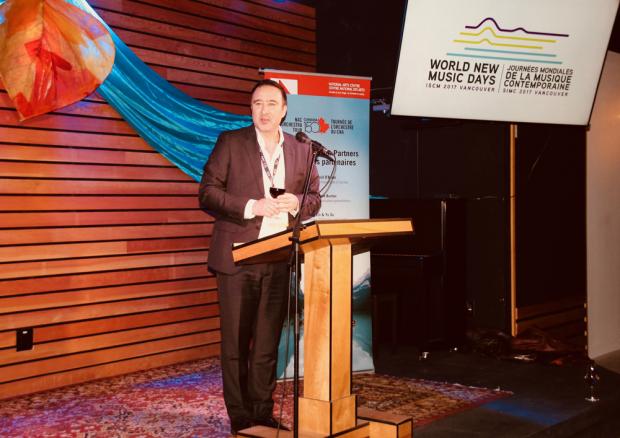
But my actual introduction to the whole affair came via a man named Frank J. Oteri, a composer, writer, and member of the ISCM executive committee, who had been charged with “handling” the commission of the report, and whose own engaging report from last year’s WMD (it was really hard for me not to notice that the acronym for World Music Days was also the one for Weapons of Mass Destruction) would be my literary guide.
After a 5-minute phone conversation on opening night, we met briefly at a cocktail reception and had a 3-minute conversation in a dark stairwell. Something like an instinct for martyrdom—or perhaps catching the religious fervor for new music that permeated the buzzy atmosphere—made me say, “Yes, I’ll do it.”
Besides the punishing concert schedule, one of the challenges was getting last minute tickets for many of the sold-out events, adding an element of surprise as well as mild panic to the whole experience.
The first night’s offering was an all-Canadian program called Life Reflected, featuring the work of 3 women composers and one man, with works about 4 notable Canadian women, performed by the National Arts Centre Orchestra. The immersive, inter-disciplinary pieces married music with computerized graphics, film, choreography, and literature—an intriguing new direction for the NAC orchestra rather like audio-visually rich recitativo.
NAC Orchestra Music Director Alexander Shelley worked closely with creative producer and director Donna Feore on the four works featured on the program, which were all commissioned in honour of our country’s 150th anniversary. It’s been touring Canada before arriving in Vancouver at the Moshe Safdie-designed Centre, a 1,837 seat performing arts theatre that also doubles as an American inspired evangelical church.
The first piece, Zosha di Castri’s Dear Life, based on a story by Alice Munro—once called “Canada’s Chekhov”—was arguably the strongest marriage of form and function. Munro’s earthy, poignant prose about life and madness in small town Ontario—adapted by writer Merilyn Simonds—was complemented by an equally sensitive score and simulated photos evocative of Munro’s own childhood in Huron County. Jocelyn Morlock’s My Name is Amanda Todd was a moving tribute to the spirit of a young woman who, in spite of her tragic fate (a suicide after being targeted by an abusive online troll) demonstrated great courage, telling her story on YouTube via a series of cue cards. The composer worked closely with Todd’s family and her music, which was combined with computer graphics evocative of constellations, conveyed a sense of the girl’s adolescent soul rising above the horrors of her tormentors and communing with the cosmos. Nicole Lizée’s Bondarsphere celebrated the life of Canada’s first woman astronaut with a televisual cornucopia of ‘80s era footage that read like pure Canadiana—with iconic newscasters like Knowlton Nash—and triumphalist shots of Bondar and her fellow astronauts. The visuals combined with a punchy score to convey both Bondar’s accomplishments and her love of science and encouragement of a whole generation of Canadian girls to pursue their dreams.
The last piece, John Estacio’s I Lost My Talk, based on a poem by First Nations writer and activist Rita Joe, featured a film of a native dance troupe interpreting the words and music in what looked like traditional Mi’kmaq territory. The narrative is based on the writer’s experience of the infamous residential schools operated by the Canadian government that stripped native children of their culture, language and identity. (The last one closed in 1996.) While the performances were powerful, the music—to my ears at least—often verged on Disneyesque cultural appropriation.
Friday’s program at the Roundhouse Community Arts and Recreation Centre in Yaletown, an historic neighbourhood that went from industrial to artist loft district to luxury condo haven in the wake of Expo 86 (the world’s fair), began with a traditional Coast Salish welcome. First Nations peoples are disproportionately represented in the city’s rapidly gentrifying drug ghetto called the DTES (downtown eastside), a 10 minute walk from the Roundhouse, but it has become a standard feature of most civic events of the last few years to acknowledge that they are taking place on “unceded Coast Salish territory”—a reference to the unresolved treaties of British Columbia.
That afternoon Montreal’s Bozzini Quartet played four pieces by international composers. A highlight was Lithuanian Egidija Medeksaite’s Megh Melhar, inspired by the Hindustani classical raga of the same name, which is associated with the coming of the monsoon season. The piece deftly explored the concept of raindrop as microcosm, through bird-like trills deconstructed and slowed down. The effect was sublime. Also of note was young American composer Sky Macklay’s Many Many Cadences which recontextualized traditional chord progressions in constantly shifting keys and registers in an attempt to subvert the “colonialist white supremacist capitalist patriarchy.” The piece had an urgency and currency that felt very “now.” Macklay’s next project is an opera about a conversation between the uteri of a woman and her surrogate.
After scarfing down a rather unpalatable bit of dinner for fuel (eating and sleeping properly would prove to be elusive goals throughout WMD- all the better for breaking down the ego and contributing to the cult of new music!) while simultaneously chatting with Macklay, I managed to make it to one of the festival highlights—a concert of New Works and String Orchestra at the Orpheum Annex—just in the nick of time.
Designed by DWD Theatre Design and Consulting, the Annex will always remind me of dearly departed Tom Cone, a shining light of Vancouver’s new music scene, as my first concert there in January 2012, during the city’s Mahler Festival, featured Love thy Neighbour with his witty libretto and Edward Top’s innovative new opera composition.
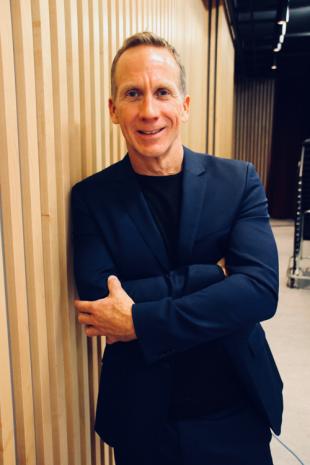
The concert proved a moveable new music feast that began with Arizona-based Canadian composer Kotoka Suzuki’s In Praise of Shadows, a piece inspired by an essay by the Japanese author Jun’ichirō Tanizaki that uses light and shadow as respective representations of Westerns and Eastern aesthetics. A kind of musical take on the concept of wabi-sabi (the rough and the refined), the piece successfully uses architectural drawing paper as instruments and celebrates its very materiality. Continuing on the theme of paper, the VEE (Vancouver Electronic Ensemble)’s ISCM Remix was a delightful and inventive symphony of paper sounds. As someone with acute audio sensitivity who is endlessly annoyed by the sounds of people rattling programs and candy wrappers at concerts, I loved the orchestral fetishization of these very same sounds. With conductor Giorgio Magnanensi (who is also a composer in his own right) at the lead, audience members were encouraged to join in this “sound experiment” via colour coded actions ranging from purple for “crumple the paper quickly and loudly” to blue for “wave/flap the paper in the air to yellow for “rub the paper between your hands rapidly.” I was one of a handful who got “black” for “roll the paper into a tube and blow air through it” (tougher than it sounds). The resulting sounds were whimsical and enlightening, although some of the instructions were challenging for non-English speaking natives, in particular one older Asian lady who didn’t quite understand the meaning of “crumple.”
After the intermission, three Canadian premieres followed with a final piece by composer Jay Schwartz. The first, Orient Point by New York-born, Toronto-based Linda Catlin Smith, offered a lush soundscape evoking the easternmost tip of Long Island. Next up was Michiko Fukazawa’s Lemminkainen’s Mother based on the Kalevala, the national saga of Finland. It was followed by Italian composer Serena Teatini’s Mi Fa which, according to the composer’s program notes, were inspired while sipping wine at a disco; it is a peripatetic piece full of drama and emotion based around repetitions of the notes E and F.
But the last piece, Jay Schwartz’s Music for Orchestra III, was akin to a religious experience. Playing with glissando harmonic progressions, the piece lands on major thirds, fifths, and unisons and then quickly moves on to the next landing point. The fluttering microtones in between speak to the ephemeral and eternal, the ancient and the avant-garde, all the while focussing purely on organic sound. The third movement ends with a rapid descent, suggesting gravity or perhaps even the fall of man, that reminded me somehow of an inversion of Bach’s cello suite no 1 in G major. With a view to the Chaldeans’ theory of constellations joining in a cosmic chant (not to mention more recent scientific experiments that have recorded the sounds of planets), I half expected aliens to land during the full moon performance. The mesmeric piece evoked the music of the spheres, reducing audio to a pure state, like the Mother of All Sound. This is a piece I would love to play on my next trip to the Sumerian ziggurat in Ur.
I only managed to take in a few minutes of John Korsud’s impressive Riot, with dynamic videography, about the Stanley Cup riot in Vancouver, as the volume was too loud for my vestibular neuronitis (and left my ears ringing for a while). But the bit that I caught managed to capture the essence of that odd milestone in our civic history.
Saturday offered an afternoon performance of New Vistas, “The Latest in Choral Music,” at Christchurch Cathedral, the historic downtown landmark that hosts the summer Bach Festival and the place where two sets of my great-grandparents were married. Located in the centre of town, its hallowed halls always invite a sense of sanctuary, and the program opened fittingly with Jordan Noble’s Lux Antiqua. A paen to the constellations, the otherworldly a capella piece for mixed voices invoked names of stars in Arabic, Greek, and Latin, plus one in Chinese, and expressed an ancient and current longing for light. Egyptian-Austrian composer Amr Okba’s Faith, was an inspiring journey through Jewish tehillim, Coptic liturgy, and Quranic recitation. Beginning with an invocation of ancient Egyptian deities, as well as the names of God in the three Abrahamic faiths, the piece explored co-existence and conflict with three distinct male voices tempered by two women acting as a kind of celestial chorus. A rather striking visual aspect of the performance was the sight of a pale red haired Canadian man chanting allahu akbar a few feet from the Anglican altar. New York based Michael Bussewutz-Quarm’s gospel influenced, beautifully nuanced, I’ll Fly Away, ostensibly about the afterlife, made me think of current interracial realities in America. Pieces performed by the Elektra Women’s Choir, directed by Morna Edmundson, included Estonian composer Tõnu Kõrvits gorgeous Song of Songs-inspired Laulud laulude laulust and R. Murray Schafer’s delightful The Star Princess and the Waterlilies with a strong vocal performance by Fabiana Katz as the princess. I left the hushed sanctuary of the cathedral for a jaunt out into the noisy, fraught downtown world, and a coffee with Brussels-based Peter Swinnen, who told me the creation story of the ISCM he presides over.
ISCM’s president since 2013, Swinnen recounted the society’s 1922 origins in Salzburg and its emergence as a kind of musical United Nations. Of course, it’s still a little Eurocentric, as it developed primarily around the countries of the old Austro-Hungarian Empire, before moving into the Soviet Union and most of the Eastern bloc nations. (I learned later from executive committee member Olga Smetanová that after the Soviet invasion of her native Czechoslovakia in 1968, many ISCM member countries applied some musical diplomatic pressure and boycotted the conference to be held that year in Warsaw.)
Indeed there was musical shuttle diplomacy happening throughout the current WMD. For my part, I offered to put Swinnen in touch with symphonies in Baghdad and Tehran, places that had first instilled in me a sense of how Western orchestral traditions could be made intrinsically Iraqi or Iranian.
As I took Swinnen on a micro-tour of the late great Arthur Erickson’s Robson Square, itself a kind of hushed urban sanctuary and modernist cathedral, he told me that “new music is immune from globalization.” Indeed, at the risk of national essentialism, it was true that each piece I heard at the WMD was infused with its own cultural identity. But whether it was nature or nurture remains open for discussion. As we walked past a giant football stadium blaring pop music, we discussed the opening night piece I Lost My Talk. I asked Swinnen if any Belgian composers had dared incorporate, say, Congolese music into their pieces.
“Our colonialism is different,” he said frankly. “It’s outside of our country not within it. So we have less taboos about cultural appropriation.”
That said, he confessed it was mainly in the world of jazz—not new music—that Congolese musical influences occurred.
Back the Sandman Hotel, a centrally located but oddly corporate HQ for such a rarefied international new music crowd, Swinnen introduced me to the team from Beijing who will host next year’s WMD. The entire executive committee soon arrived for a dinner, and I waved goodbye as they went out into the snowy night, waiting for my ride home in the freezing lobby. The only other waiting area option was a place called the Shark Bar full of blaring sports screens and top 40 music. It was an impossible choice between two tortures, but at least the lobby was quieter.
To distract myself I imagined the ISCM executive committee as the XMen of the new music world, fighting a global cultural jihad against mediocrity and homogenous commercialism. Could they save the planet, promote world peace, or at the very least encourage more new music commissions?
I arrived home in a freak snowstorm, exhausted but exhilarated, my head buzzing with strange new sounds. Waiting for me was a WhatsApp message from Nabil in Najaf, wishing me a good dua (both a gift and supplication) for Arbayeen.
Sunday evening took me to the historic 90 year old Orpheum cinema turned theatre (barely saved from the wrecking ball in the ‘80s) which is home to the Vancouver Symphony Orchestra. Resident composer Joceyln Morlock began the program with her piece That Tingling Sensation—about that ineffable feeling music can bring. Its dream-like cadence continued with Charlotte Bray’s mid-century feeling At the Speed of Stillness based on a surrealist poem by Dora Maar, followed by Friedrich Heinrich Kern’s more nightmarish Indigo. The long awaited world premiere of sitarist Mohammed Assani and composer John Oliver’s Pressed for Time brought a big South Asian contingent out to the VSO’s traditionally more monochromatic crowd.
While I may have been somewhat distracted by the sound of the Indian granny behind me searching for something in the pocket of her ski jacket for 10 minutes of the 20 minute “sitar concerto” (perhaps the Vancouver equivalent of the gallerist and her noisy jacket in Jonathan Parker’s 2009 cinematic send up of the downtown NYC art and new music scene Untitled), there was definitely something disjointed about the piece. It was Kiplingesque, both in terms of the oddly Jungle Book-influenced score, as well as in terms of his famous adage about the East and the West. In this case, they definitely failed to meet. Perhaps it was the lack of rehearsal time, but it felt as if the sitarist and his tabla player were in a different country than the VSO. Assani’s ragas were lovely but, for me, the orchestration verged on Bollywood clichés.
Luckily the evening was saved by an intriguing performance at the adjacent Annex. A ten minute piece called Stitches by Sweden-based Brazilian composer-performer Leo Correia de Verdier, who arrived on stage wearing a skirt and high-heeled suede boots, channeled a favela seamstress stitching to a Salvadorian-infused percussive back beat. What followed—Antrthopologies Imaginaires, a 40 minute performance piece by Quebec-based Trinidadian-Canadian Gabriel Dharmoo—was another festival highlight. While a piece that promises commentary on “post-colonialism, post exoticism, cultural extinction, globalization, normalized racism, and cultural appropriation” may not seem particularly fun, the often hilarious “mockumentary” on bizarre musical practices of “primitives” around the globe was social satire at its best. From a province with a notorious anti-immigrant bent (and a fixation with “barbaric cultural practices”, “reasonable accomodations” and banning the niqab) the piece was also a cri du Coeur. After a tour de force vocal performance ranging from musical water bubbling to the exquisitely drawn “preventative exorcism”, critiqued by “experts” and the “minister of assimilation,” Dharmoo’s character offered a silent, desperate scream.
But at new music festivals, no one can hear you scream, and after four days of intense listening, interviewing, concert going and fitting in rent-paying deadlines and pit stops for emergency groceries, meals and laundry in between, the mental strain was starting to show. There’s something bonding about a shared experience of musical exhaustion and that combined with days of speaking pidgin English, high school German, and second and third language French and Spanish, I felt once again like the mad man in The Name of the Rose. But the common language that emerged from our performance-oppressed brains was music, or more precisely, stripped of that pretense, sound.
Monday, day five of my new music pilgrimage, was marked by another remarkable performance from la belle province. ECM (Ensemble Contemporain de Montreal) performed four pieces by composers from around the world, followed by a post-intermission performance of four more pieces by Vancouver’s Turning Point Ensemble. My solitary reviewing spell was broken when the seat next to me was taken by young Polish-born composer Grzegorz Pieniek, whose piece opened the program (which was, like many, being live-streamed so that Grzegorz’s mother in a small town in Poland was able to tune in). He asked me to take photos with my iPhone of his post-performance bow, and I got a sense of how important WMD is to young composers internationally. The piece by the now Vienna-based composer, Jede Nacht Besucht Uns Ein Traum, was based on a collection of drawings and prints by Austrian graphic artists Alfred Kubin, viewed at the Albertina Museum. Pieniek told me he is often inspired by art and film, and the nine-minute piece was a musically evocative ode to Kubin’s macabre, nightmarish visions.
While new music can sometimes feel bleak and dystopian, after a week of deep listening I feel the opposite is true. It’s an exciting way of expressing the reality of our time. This sense of musical zeitgeist was evident in another program highlight, Astiro by Spanish/Basque composer Inaki Estrada Torio. Full of urgent outbursts and often lyrical moments of beauty, the piece played with the concepts of time and the development of sound itself. Serbian-Canadian composer Ana Sokolovic’s Evta enjoyed its world premiere, showcasing the exceptional playing of Canadian violinist Andrea Tyniec. Returning once again to the Pythagorean theory of music and colour and perhaps even Chaldean cosmology, the piece (Roma for “seven”) combined a mystical exploration of the seven chakras corresponding to the seven notes of the scale with Balkan gypsy melodies.
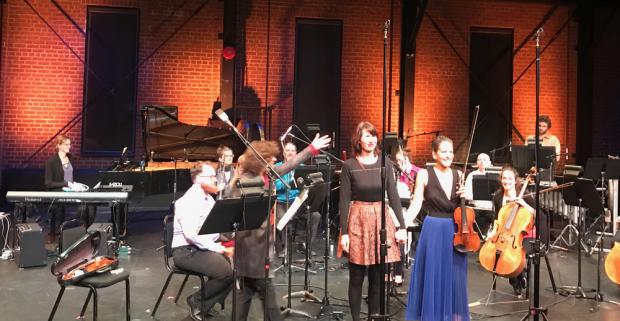
Chakras aside, I seemed to graduate to a new level of new music too cool for schoolness that evening when the charming young Polish composer insisted that I join him for a drink in the inner sanctum of the WMD: the back room of the second floor eatery at the Sandman Hotel. En route, walking in the freezing night, I was asked some difficult questions by the Polish composer. “Why are there homeless in such a wealthy place?” he asked, quite rightly, of the world’s least affordable cities for housing, as we passed a shivering, scowling man huddled in the doorway of a new luxury condominium tower. And, in the shadow of gleaming new gazillion dollar sports stadiums and casinos, “Where is your opera house?” and then “Why don’t you have one?”
Once ensconced in the upper echelons of the Sandman, for the first time during the festival I was actually able to socialize in a more informal setting with composers and musicians, in what could almost have passed—corporate hotel architecture aside—as a WMD salon.
I had long abandoned my laminated badge—my de facto WMD visa—that said simply “Media”, as everyone else had name tags and people had taken to calling me “Medea”. Since no one had time to introduce me properly to the composers or guests in attendance, my post-concert questions were often greeted with “who are you exactly?” looks of consternation. If I were a secret new music spy, I wonder, where would I publish my findings? Who would care? And how would I ever make a living with my espionage?
I chatted that night with Dharmoo about colonialism in Canada, and the unbearable whiteness of the new music scene. I suggested we pen a mock musical called where are you from? I heard more about Vienna from Grzegorz, and after days of being a captive audience member, did an impromptu pop up performance of a Serbo-Croat gypsy song for the Balkan contingent – (documented for posterity on an iphone by Dharmoo) even breaking the unwritten WMD taboo against dancing. A few minutes later, a Canadian ISCM “ambassador” approached me for the first time in five days and said, “Lovely song – where are you from?”
“Vancouver,” I replied, unblinking. She looked puzzled.
And with that, I was off into the dark stormy night to pass out in my overpriced studio, and prepare for the second to last day of my pilgrimage.
Happily, on Tuesday we moved out of the downtown core and convened at the University of British Columbia, my old alma mater, for an electroacoustic music concert presented by the UBC Computer Studio. En route I made a few last ditch frantic calls to Iraqi embassy officials to see if there were any faint hope of getting a visa in time for Arbayeen, an act in itself akin to self-flagellation.
Early birds had managed a visit to Arthur Erickson’s magnificent Museum of Anthropology, a testament to Goethe’s declaration that “architecture is crystallized music.”
At the concert I sat next to composer Kristian Blak, who had come all the way from the Faroe Islands. A highlight of the program was Canadian Barry Truax’s The Garden of Sonic Delights, evocative of a bird-filled Eden felled by a single gunshot and somehow fitting in the rainforest turned real estate wars setting. The Canadian premiere of Clemens von Reusner’s Definierte Lastbedingung was an interesting counterpoint to the sonic delights recreation of the natural world. Here, the often clunky sounds of electromagnetic fields via electrical devices used at research institutes, oddly reminiscent of the early ‘80s German band Einstürzende Neubauten, were yearning for some organic ideal. Just as androids dream of electric sheep, these industrial sounds were rather poignantly—like Hal in 2001—longing to be human.
A subsequent “awesome talk” by five international representatives from different ISCM sections was a fun and enlightening look at challenges faced by new music composers around the world. Anna Murray, president of the Irish section, spoke of the tricky business of creating a culture of criticism in a relatively small community of composers. French section president Raoul Lay simply conducted a chorus of “hellos” in different languages; and Japanese section president Tomoko Fukui spoke of the growing popularity of and audience for new music in her country. Swedish section president George Kentros waxed philosophical on the distance between perfection and imperfection, saying “The more abysmal experience of the actual, the higher the expectations for the virtual,” noting that at WMD’s “We hear great pieces and pieces we hate…but even the bad pieces imply a horribleness that points toward an ideal.” He ended his talk by saying, “(to) keep playing that’s all we can do.”
If the ISCM really is the musical U.N.—imperfections and all—could Kentros’s statement be applied to a broader audience? I wondered. I’d written before about the power of Yugoslav rock music of the 1970s to unite Bosnians, Serbs, and Croats at a night club in early ‘90s London; of the ability of orchestral music to unite disparate factions in Iraq and Israel/Palestine; and Persian classical music as a means of resisting a theocratic regime. But could new music really save the world?
While in the first few days of the WMD, I’d often felt a direct relationship between the compositions I heard and the state of the world, I was now at a point where the outside world had retreated into a more insular world of sound. I’d stopped watching the news altogether, partly out of sheer exhaustion.
A place was found for me on the bus back to the hotel, and I was a momentary tourist in my own town, pointing out vistas and attractions as we drove through my neighbourhood of Kitsilano, named after the chief Khatsalano and his people, evicted over a century ago by developers to make way for white settlers.
That afternoon I met with ISCM Canadian Section President Jim Hiscott at the Sandman Hotel bar for an interview. Miraculously, the bartender kindly agreed to lower the volume of the top 40 music so I could hear Jim’s soft-spoken Manitoban voice.
When I asked the Winnipeg-based composer why he was so passionate about new music, arguably a difficult career path for any composer or player, he replied, “It’s the closest thing to being completely alive that I know.”
We walked the short distance to the Post, HQ for a handful of cultural non-profits including Music on Main. As we entered the CBC building en route, a South Asian security guard eyed me suspiciously as I walked in with tall, half-Ukrainian Jim and asked for ID. “That’s odd,” said Jim, “He never bothers me.”
I grabbed a coffee and spoke briefly with David Pay, grateful for the momentary sanctuary offered by the artist run space in the heart of downtown.
“New music allows us to tap into what’s happening today,” he said. “And it’s a beautiful expression of how we can all get along.” One of his goals with the festival, he recounted, was to “create an environment where people can listen with open hearts.”
But Pay warned against the dangers of taking the “music to soothe the savage breast” idea too far. “New music can also agitate people to action,” he said.
Vancouver, said Pay, is a “place of possibilities, with Europe to the East and Asia to the West,” 10,000 years of First Nations history, and yet a musical culture not “tied to tradition” in the same way that, say, Vienna is. This ethos allows for a certain freedom, he contends.
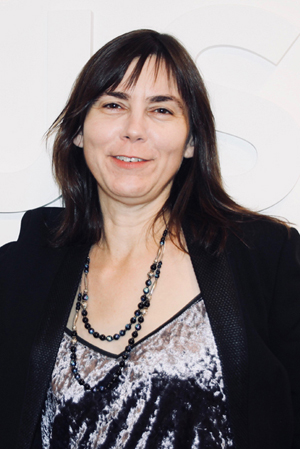
Pay said he sees Vancouver as having four main schools of new music: 1) an improvisational scene – exemplified by the likes of cellist Peggy Lee; 2) inter-culturality, a potent blend of new musics from China and elsewhere married to more Western traditions like the work of Red Chamber – whose November 5th concert was sold out; 3) the idea of soundscape which was essentially born here (by the likes of R. Murray Schafer, a professor at Simon Fraser University, the Arthur Erickson designed university where my parents were charter students and where I grew up); and 4) a “Keatsian pursuit of beauty,” as evidenced in the work of Jocelyn Morlock and Rodney Sharman.
Pay is rightly proud of the fact that this WMD is the first to have almost gender parity with 46 of the 92 words presented by women composers and the rest by men and transgendered people.
He admitted that cultural diversity is more of an ideal than an actuality, with the musical U.N.’s WMD this year being “essentially white with some Asian.”
“It’s an on-going challenge,” he said. “If you don’t see yourself reflected on stage, you don’t see new music as a viable career path.”
Sadly the only black composer at WMD, the Belgian-Rwandan Aurelie Nyirabikali Lierman, cancelled the performance of the world premiere of her piece for solo percussion after a flu felled the Canadian percussionist and limited rehearsal time.
It was now the eve of Arbayeen and I hadn’t heard from Nabil in a few days. I had officially given up on getting to Iraq in time. It was the moment for an unexpected epiphany.
As I walked, sleep deprived and hungry, toward the Annex for an afternoon concert, I felt something akin to an experience during my last year’s visit to the film festival in Tunis. After days of watching Tunisian cinema, I walked back to my hotel one afternoon and found that the distance between the screen and the street had simply disappeared. I had entered into a Tunisian film.
Similarly, as I turned the corner onto Seymour Street from Georgia, I walked into a live soundscape. Car horns, music blaring from radios, cyclists braking, motorists yelling, the rhythm of jack hammers all sounded suddenly as if they’d been curated especially for me in that moment. Music was alive and magic was afoot.
At the Annex, in a program curated by Vancouver’s Powell Street Festival Society, I was delighted to hear Canadian composer Justin Christensen’s This is Fun for Me, even if you don’t think it is, played by the dynamic Tiresias Duo of flautist Mark Takeshi McGregor and pianist Rachel Kiyo Iwassa. With text by Judith Butler read aloud by McGregor, the playful cabaret piece seemed to be a metaphor for the whole WMD experience.
“Love is not a state, a feeling, a disposition, but an exchange, uneven, fraught with history, with ghosts, with longings that are more or less legible to those who try to see one another with their own faulty vision.”
and
“Let’s face it. We’re undone by each other. And if we’re not, we’re missing something… One does not always stay intact. One may want to, or manage to for a while, but despite one’s best efforts, one is undone, in the face of the other…”
This piece was followed by what can only be called an urgent piccolo solo. (When I mentioned this to McGregor over drinks later he retorted all piccolo solos are urgent.)
The lone Middle Easterner (or perhaps Asia Minorer?) at WMD, Turkish composer Murat Colak’s piece Nefes. Pas. Cira. ISI was a sublime, seemingly Sufi inspired meditation on the nature of sound performed on flute and percussion, and one of the most refined compositions I heard all week.
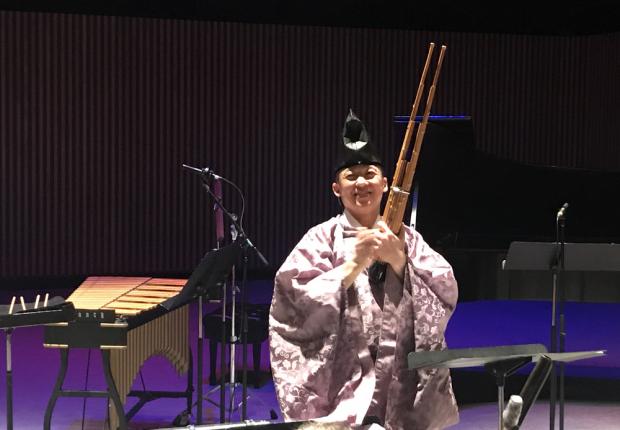
Yasunoshin Morita’s ReincarnatiOn Ring II for Sho, U, and iPods, was pure visual theatre, with Japanese musician Ko Ishikawa emerging on stage in traditional dress and hat, offering a reflection on technology, sound, and music. Acting as a mediator for the reincarnation of broken iPods, his traditional instrumentation was augmented by surround sound of iPod installations.
The piece seemed to beg the question, do iPods have a soul? Intriguingly, right before the preceding piece Thinking Eden, a thoughtful reflection on the idea of “original light” for flute, piano and percussion by Romanian composer Laura Manolcahe, someone’s iPhone went off in the front row, in a glorious full throttle ring tone. If it had happened 10 minutes later, it could have easily passed for part of the performance.
That evening’s concert at the Roundhouse offered food for thought on the idea of inter-culturality as a Vancouver new music “school.” One of the best examples I’ve heard in a while, was the partnering of Nicole Ge Li on Chinese erhu and Corey Hamm on piano or PEP (Piano and Erhu Project). Rather than feeling forced or artificial, there was an organic sense of cohesion in the four pieces they played together. It was an equal partnership between two excellent musicians (Hamm’s two piano solos also demonstrated his sensitive, nuanced playing), rather than a colonial fetish or afterthought.
The second half of the program featured the well regarded Vancouver Standing Wave Ensemble playing an eclectic mix of compositions. Notable was the world premiere of Jordan Nobles’s Echo Chamber, an eight-minute piece that like much of his work exuded a profound sense of grace and mystery, and also one that explored both the literal resonance of sound and the figurative idea of ideas reinforced within a closed system. Estonian Mart-Matis Lill’s When the Buffalo Went Away featured the rich baritone narration of the Jonathan Lear poem about the decimation of Plains Indian culture by local Lil’wat First Nations artist Russell Wallace, but otherwise came across as slightly twee and well meaning. James O’Callaghan’s 2016 piece subject/object—an intellectually and technically rigourous composition for piano, ensemble and electronics, based partly on a transcription of apparent acousmatic work–would win him the ISCM Young Composer Award.
Reykjavik-based Hafdis Bjarnadottir’s Kronan was an engaging piece about the financial collapse in her native Iceland. With a background in both jazz and contemporary music, the composer and electric guitarist’s piece read like a bad acid trip of capitalist chaos. Based on actual financial graphs from the 2007-09 period, followed by soothing salvation via Icelandic nature, it’s a new music fable for our time.
But there was no rest for the wicked and I soon found myself struggling to keep up with a long legged Dutch new music festival invitee and Icelandic composer and ISCM executive committee member Kjartan Olafsson, who told me about his work in the realm of musical artificial intelligence as we jogged towards the Vancouver Public Library for yet another performance.
On offer that night was the “Vertical Orchestra 2017” 21st century guitars. Featuring 18 male electric guitarists placed on pedestals throughout the library atrium, it was narrowly saved from being the apotheosis of white male new music echo chamber wankery by the works of two female composers, notably Lisa Cay Miller, whose Helix was careful to avoid excessive reverb incumbent on such a cavernous space.
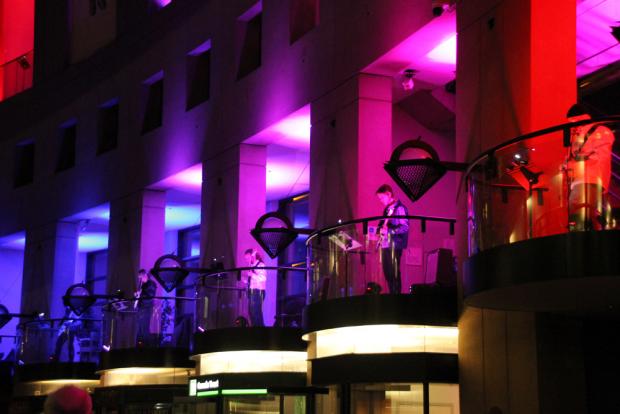
Post concert, in need of some new music saturation relief, I chatted outside with a Brazilian new music festival director and sang ranchera songs. A Canadian composer kindly offered me a lift home in the freezing night, but said, “You’re not allowed to sing.” I realized they weren’t kidding when they asked me, “So where are you from?” I shut up and took the ride home. With one day of my musical pilgrimage to go, I was less concerned with new music saving the world and more with self-preservation.
The highlight of the noon concert with the excellent Aventa ensemble on the last day of WMD was Swedish/French composer Madeleine Isaksson’s moving Isar (Swedish for “Apart”) inspired by her father’s Alzheimer’s; through repetitive phrases and bursts of anxious instrumentation, it poignantly evoked the unraveling of a mind. Other pieces of note included 26-year-old British composer Michael Taplin’s Lambent Fires, a dramatic, engaging ensemble piece which received its Canadian premiere, and the world premiere of Lied • TDU FS, Giorgio Magnanensi’s tribute to Aventa ensemble conductor Bill Linwood. In a successful fusion of audio and visual dynamics, images reminiscent of psychedelic oil lamp style complemented the sound collage composition, conveying a sense of the creative petri dish of Vancouver’s new music scene, especially the 70’s SFU era.
The Victoria Symphony shone that afternoon, playing five compositions by international composers, the highlight being Canadian-raised but now NYC based young composer Jared Miller’s Concerto Corto. The John Adams-feeling piece explored reverberation and the relationship between violin (played wonderfully by Müge Büyükçelen) and orchestra.
And then, timed to coincide with maximum WMD saturation, came the three-hour two-intermission conclusion to the musical marathon. Happily it began with pianist Eve Egoyan, whose sensitive, musical interpretations of Judith Weir’s 1983 The Art of Touching the Keyboard and Chiyoko Szlavanics’ Constellation I-III were a pleasure to experience. As performed by Rachel Kiyo Iwassa, Hildegard Westerkamp’s Klavierklang for piano and stereo soundtrack for piano and spoken voice, offered some refreshing narrative devices to complement the music. The piece was about letting go of the trap of perfectionism and embracing the messy freedom of creation (recalling George Kentros’ “all we can do is keep on playing” mantra). Remy Siu’s 2015 Foxconn Frequency (no.2) for one visibly Chinese performer explored similar territory, looking at the pressure to succeed from an Asian-Canadian perspective. Projectors flashed urgent binary code inspired images that suggested a struggle between the robotic automaton and the artist trying to maintain humanity.
Chinese-Belgian composer Hao-fu Zhang’s Lune Solitaire et Silencieuse had some gorgeous Debussy-inspired moments, while Welsh composer Maja Palser’s piece A cry, inspired by the refugee crisis in 2015, a charcoal drawing by refugee artist George Minne from WWI, and a Welsh hymn of mourning, was a balm for the soul. The evening—and the entire festival—ended on a decidedly Romantic note, with Rachel Kiyo Iwassa playing Rodney Sharman’s languidly deconstructed version of Wagner’s Liebestod from Tristan and Isolde. In many ways this last piece spoke to festival themes ranging from the tension between the ideal and the actual, the longing for perfection and the hard slog of praxis, and perhaps even the larger question of whether new music might usher in a new kind of Romantic era or die an insular death, poisoned by its own Kool-Aid.
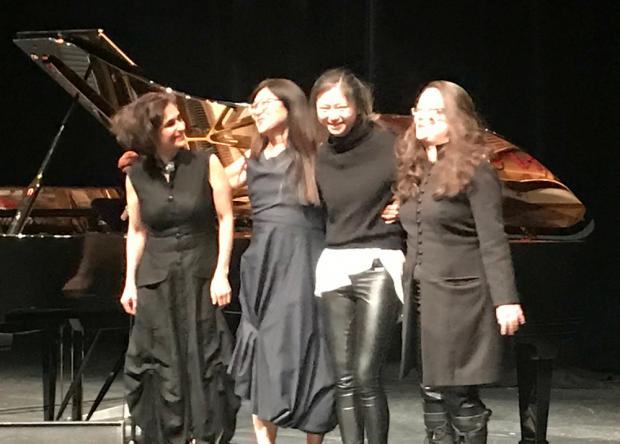
Thoughts to ponder over the giant new music love-in/after party/giant sigh of relief that was also one last networking session for an extraordinary group of international composers. Spanish/Basque composer Inaki Estrada Torio and his friend invited me for one last drink at the Sandman. But when we were almost killed by a Chinese grandmother driving an Oldsmobile who careened into the crosswalk we were crossing on a green light, I took it as a sign. Not that a little new music was a dangerous thing, or under threat from corporatized culture, or that WMDs were about wild cultural collisions, or even as some kind of next year in Beijing omen. It was simply time to go home.
It was an odd feeling to wake up the next day, my ears buzzing with newfound noise or perhaps even music of the spheres, and not rush to a concert. Instead the world came flooding back in via the television news I’d had no time to watch for a week. But something had shifted. Now news stories of looming civil wars, earthquakes and rogue leaders were re-positioned as soundscapes.
New music, I mused, is hyper-real.
But had I become a true believer? Had my mental headline shifted from new music saves world to direct correlation between new music and narcissism? Is new music really about the zeitgeist? Or about clubby schools of coolness run by vengeful ex-nerds? Is it about uniting mankind or preserving precious Eurocentrism? Is new music some secret society that allows access to a special portal of existence via some Chaldean magic? Or can it help you access that in the midst of your everyday life? Is it in fact about everyday life—or as the evangelicals say—life itself?
I decided to give it the Marxist “is art useful” test. How can you apply new music in everyday life? Can you use “new music” in a sentence? How about….I was on a crowded bus the other night at rush hour in the pouring rain and I began to listen to Jay Schwartz’s Music for Orchestra III on Soundcloud. I have to say it much improved the experience. But the best time was last night when I went for a solitary beach walk at dusk, right before a storm, and listened with all my senses alive.
Amen.
###
Hadani Ditmars is a Vancouver-based writer and performer who works internationally. Her 2006 book Dancing in the No Fly Zone documents pre- and post-invasion culture in Iraq and includes several chapters on the Iraqi National Orchestra, whom she assisted by arranging for sheet music, violin strings, oboe reeds etc. to be brought in under sanctions.(She has also broadcasted the work of Iraqi composers on CBC radio.) Her next book, Between Two Rivers: a Journey Through the Ancient Heart of Iraq (for London’s IB Tauris), is a travelogue using ancient sites as a narrative device to tell the story of Iraqi culture today. Hadani is a past editor at New Internationalist and her work has been published in the Guardian, the Independent, the NY Post, the New Arab, Al-Jazeera, Sight and Sound, Walrus, Haaretz, Ms. Magazine, The New York Times, the Art Newspaper, Vogue, and Architectural Review. She is currently working on an apocalyptic cabaret for piano and voice, as well as arrangements of traditional Sephardic songs with Middle Eastern musicians, including a Syrian refugee violinist and an Iraqi oud player in exile.

Hadani Ditmars
